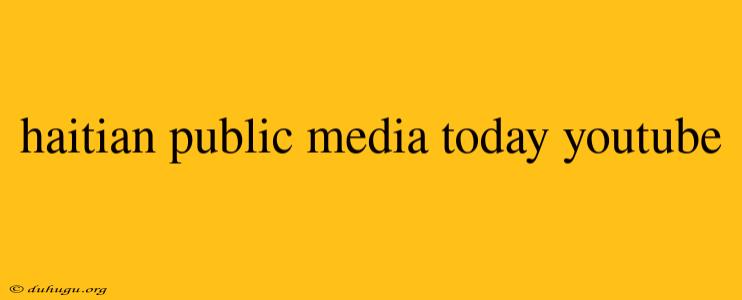Haitian Public Media Today: The Rise of YouTube
Introduction
Haitian public media has undergone significant transformations in recent years, with the rise of digital platforms and social media playing a crucial role in shaping the media landscape. Among these platforms, YouTube has emerged as a leading platform for Haitian content creators, providing an outlet for self-expression, education, and entertainment. In this article, we will explore the current state of Haitian public media, the impact of YouTube, and the opportunities and challenges that lie ahead.
The State of Haitian Public Media
Haitian public media has historically been dominated by traditional outlets such as radio and television. However, with the advent of digital technology, online platforms have become increasingly popular, offering a more accessible and affordable means of reaching a wider audience. Despite this, the Haitian media landscape still faces significant challenges, including limited resources, infrastructure, and funding.
The Rise of YouTube
YouTube has become an integral part of Haitian public media, providing a platform for content creators to produce and share content with a global audience. With over 2 billion monthly active users, YouTube offers an unprecedented opportunity for Haitian creators to showcase their talents, share their stories, and connect with others.
Types of Haitian Content on YouTube
Haitian content on YouTube is diverse and varied, encompassing a range of genres and topics, including:
- Music: Haitian music videos, live performances, and behind-the-scenes footage.
- Vlogs: Personal vlogs, daily life, and cultural experiences.
- Education: Educational content, including language lessons, cultural explanations, and tutorials.
- News and Current Events: News, analysis, and commentary on current events in Haiti and the diaspora.
- Comedy and Entertainment: Sketch comedy, parody, and entertainment content.
Opportunities and Challenges
While YouTube has opened up new opportunities for Haitian content creators, there are also challenges that need to be addressed, including:
- Monetization: Many Haitian creators struggle to monetize their content, due to limited advertising revenue and lack of sponsorship opportunities.
- Censorship and Regulation: Concerns around censorship and regulation of online content, particularly in relation to political and social issues.
- Infrastructure and Access: Limited access to reliable internet and electricity in Haiti, which hinders the production and dissemination of online content.
- Representation and Diversity: The need for greater representation and diversity in Haitian content, including more voices, perspectives, and experiences.
Conclusion
Haitian public media has undergone significant transformations in recent years, with YouTube emerging as a leading platform for content creators. While there are opportunities and challenges, the rise of YouTube has opened up new avenues for self-expression, education, and entertainment. As the Haitian media landscape continues to evolve, it is essential to support and empower content creators, address the challenges they face, and promote greater representation and diversity in Haitian content.
